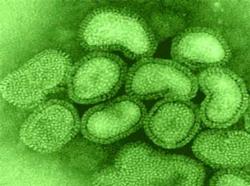Highly Pathogenic Avian Influenza (HPAI)
The following is compiled from USDA & CDFA fact sheets about HPAI:
What is Avian Influenza?
Avian Influenza (AI), commonly called the bird flu, is a disease found among a wide variety of birds. AI viruses can infect chickens, turkeys, pheasants, quail, ducks, geese and guinea fowl, as well as a wide variety of other birds, including migratory waterfowl.
The strains that have recently been found in the U.S. have not been found to affect humans.
AI viruses can be classified into low and high pathogenicity forms based on the severity of the illness they cause in poultry. Most strains are classified as low pathogenicity AI (LPAI) and cause mild clinical signs. In contrast, high pathogenicity AI (HPAI) causes a severe and extremely contagious disease.
Waterfowl are reservoirs for Avian Influenza (AI) strains. Some of these strains can be fatal to domestic poultry, yet show little to no signs in waterfowl. Because many waterfowl species migrate in the fall and spring crossing many borders, the risk of transmission of AI to backyard and commercial poultry increases during this time.
If you observe signs of illness or increased mortality, please call:
Sick Bird Hotline (866) 922-2473
Register with
California Backyard Poultry Census
Current information about AI:
Avian Health Program CDFA
HPAI Factsheet (English)
HPAI Factsheet (Spanish)
Clinical Signs of AI
Clinical signs may appear as soon as 3-5 days after viral exposure. Mortality rates vary widely depending on the pathogenicity of the virus, concurrent infections and environmental stress.
Affected poultry may not show signs, but the ones that do may include any or all of the following:

- Respiratory signs (coughing and sneezing)
- Depression
- Sudden death
It can also manifest in other ways such as:
- Decreased feed and water consumption
- Decreased egg production
- Soft or misshapen eggs
- Swollen heads and bluish combs
- Hemorrhages on internal organs, feet or legs
- Diarrhea
- Nervous disorders
BIOSECURITY
Biosecurity includes any practice that can reduce the risk of introducing disease to a premises. To be effective, biosecurity must be practiced diligently at all times, without exception, by everyone that comes in contact with the premises.
Biosecurity practices that can reduce the risk of AI transmission:
- Permitting only essential workers and vehicles on the premises
- Providing biosecurity training to employees
- Do not share birds, equipment or feed with other bird owners
- Avoid visits to other backyard flocks or poultry operations
- Restrict access to your birds; if visitors are necessary, provide disposable coveralls, boots, and head coverings
- Isolate new birds from your other birds for 30 days and observe them for signs of illness
- Scrub and remove all debris from your footwear, giving particular attention to the soles, with soap and water and spray with a disinfectant
- Consider using a disinfectant foot bath with a scrub mat at the entrance to your bird area
- Thoroughly clean and disinfect (C&D) vehicles and equipment entering or leaving the premises
- Protect flocks from exposure to wild birds, rodents and insects
- Control movement associated with the disposal of mortality, litter and manure
Highly Pathogenic Avian Influenza has been recently found in migrating waterfowl in the Pacific Flyway and associated backyard/commercial poultry flocks. It is critical for poultry owners to keep their birds from having contact with waterfowl and wild birds. Here are some tips:
- Discourage waterfowl from using ponds on your property
- Avoid on-farm traffic patterns that cross waterways
- Keep poultry confined in houses and/or enclose an exercise area with netting
- Avoid use of water that comes from sources where waterfowl may congregate during migration
- Producers and employees should avoid waterfowl hunting during migration; otherwise, ensure clothing, footwear, vehicles, etc. used during hunts are laundered and/or disinfected
Necropsy Services for Poultry Owners
See Necropsy Options fact sheet for submission of dead birds.

